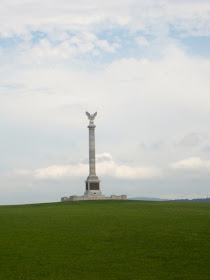Last summer, T and I pulled up stakes and spent a few days visiting Gettysburg, Pennsylvania, the site of a three-day battle that changed the course of the Civil War. Gettysburg occurred in July 1863 and the Union victory turned the tide of the conflict; Rebel forces would never again invade North. But the war wasn’t over after Gettysburg. Nearly two more years of brutal destruction followed.
Gettysburg today is a beautiful place with acres of the battlefields preserved. There are monuments to the soldiers who fought here and the sheer volume of them gives one pause. There were 50,000 casualties in the three day battle; nearly a third of the soldiers who fought on those days. That the war would last nearly two more years after those three days of miserable carnage tells us how divided the nation had become.
This past week, T and I stepped back in time again, this time visiting Antietam, in Maryland. This battle happened in September 1862 and is most often remembered as the Union victory that enabled President Lincoln to issue the Emancipation Proclamation, which freed enslaved men and women in the rebellious states. Beyond emancipation, Antietam was a battle that taught both the Union and the Confederacy of the need to engage in a more ordered brutality. In the aftermath of the immediate fighting, the fields around Antietam Creek were littered with the corpses of the dead and dying, as both sides struggled to organize a plan to remove the injured and bury their dead. This fact is sometimes hard to remember when one stands in the fields that saw fighting in 1862. It seems so peaceful now.
Though the battle is considered a Union victory, it was just barely that. More accurately, the battle should be described as a failed Confederate invasion of the North. When the smoke had cleared, the Union still held the land around Antietam Creek. The Confederate Army slipped back over the Potomac into Rebel-held territory in Virginia and lived to fight another day. In the aftermath, both sides developed plans for organized field hospitals, evacuation of the injured, and burial of the dead. Nearly 23,000 casualties in one day is sobering in that fashion.
In both of these places, the beauty and peacefulness of the fields belies the brutality that divided this land more than 150 years ago. I’m accustomed to teaching the Civil War as a bloody, hand-to-hand fight between brothers, and that’s certainly true. Horrifying as that idea is, seen up close it’s even more shocking.
I’m struck by the notion that our ability to understand the complexity of race and inequality today is really rooted in the same animosity that drove us to the Civil War in the first place. In the years of those battles, over and over again we destroyed our homes and neighbors in pursuit of a conclusion to the question of slavery and preservation of our union. That is took such cold brutality to bring the nation to settlement of the questions is unsettling. For all the brilliant promise that exists in the Declaration of Independence and the Constitution which followed, we’ve had a mighty hard time fulfilling those ideals. Today, we regret that violence and mourn the dead. But for all that we record the history of the Civil War, I wonder if we really understand who we are and what we did to one another.






No comments:
Post a Comment